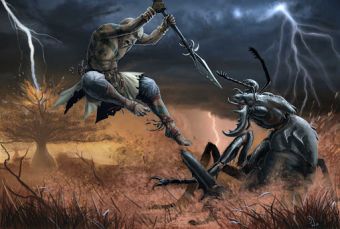Difference between revisions of "Black Ant (giant)"
Tao alexis (talk | contribs) |
Tao alexis (talk | contribs) |
||
| Line 1: | Line 1: | ||
| − | [[File: | + | [[File:Ant (giant black)-image.jpg|340px|left|]] |
| + | |||
{{Bestiarychart | {{Bestiarychart | ||
| name = Ant Warrior (giant black) | | name = Ant Warrior (giant black) | ||
Revision as of 17:51, 13 February 2020
| Species | insect (lasius niger gargantua) |
| No. Appearing | 4-16 |
| Behaviour | nest |
| Range | jungle, rainforest, savanna, taiga, woodland |
| Size | 3 ft. 6 in. long |
| Weight | 60 lbs. |
| Intelligence | 0 |
| Armour Class | 4 |
| Hit Dice | 3 |
| Action Points | 6 |
| Max. Stride | {{{stride}}} |
| THAC0 | 18 |
| Hp/Die | d4 |
| Attack Forms | pincers |
| Damage | 2-8 |
| Special Attacks | none |
| Species | insect (lasius niger gargantua) |
| No. Appearing | 10-100 (+ warriors & queen nest) |
| Behaviour | nest |
| Range | jungle, rainforest, savanna, taiga, woodland |
| Size | 2 ft. long |
| Weight | 17 lbs. |
| Intelligence | 0 |
| Armour Class | 4 |
| Hit Dice | 2 |
| Action Points | 5 |
| Max. Stride | {{{stride}}} |
| THAC0 | 19 |
| Hp/Die | d2 |
| Attack Forms | pincers |
| Damage | 1–4 |
| Special Attacks | none |
All initial encounters with giant black ants will be with one individual that is foraging. The distance of first encounter will average 1 yard's distance from the nest per total number of foragers in the lair (10–100). If it is approached within four hexes, the ant will attack, emitting pheromones as it does. This will be a signal for others of its kind to come (the odor will be picked up over a distance of 30 yards).
Soon the party will hear the rustle of ants coming from multiple directions. After the first round of combat, a second ant will appear from a random direction to attack in the second round. Thereafter the number of ants will quickly swell, as shown on the right-hand table, until all the ants have been encountered. Due to their size and the intensity of their attack, up to eight individual ants will be able to attack a typical medium-sized target. The ants will fight to the death.
Tracking skill is required to find the nest and the queen. Nests in temperate climates will be active only from early April to mid-September.
If the nest is discovered in April or May, the queen will have no special attendants, though there will likely be 4–16 of the remaining ants that are found in the chamber with her, protecting her with their lives.
Beginning in June and for each month thereafter, 1–4 of these last encountered ants will be warrior ants (2–8 total in July, 3–12 total in August and 4–16 total in September). The queen herself will be bloated with eggs and unable to fight.
On a warm day in mid-September, nests in temperate climates will be full of activity as young queens and drones, birthed in late August, swarm and mate. The drones (treat as ant warriors) will die within a day or two, while the new queens will bury themselves in random locations for the winter season.
In tropical and subtropical climates, black ant colonies will continue the year around; there will always be a full compliment of warrior ants and there will be 2d8 others that will roam astray. Some colonies may be as large as ten times in size, up to a thousand ants. Swarming times will usually be at the end of the wet season.
See Bestiary.
